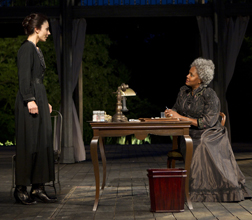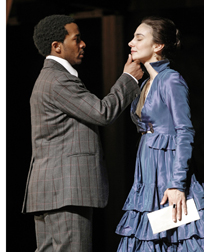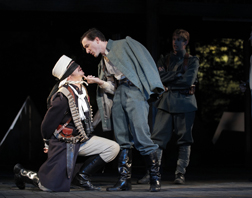By Lucy Komisar
This is a Shakespeare sex play. Didn’t know he did those, did you? The playbill has a cover that says, Shakespeare in bed. And the comic Reg Rogers, whose signature style of exaggerated and plosive speech makes him recognizable anywhere, delivers a long near-tirade to the play’s heroine, Helena (the generally cool and often hot and always excellent Annie Parisse) about the importance of getting rid of one’s virginity.

It’s not one of Shakespeare’s more profound or poetically rich works, but it gets a typically fine Public Theater production. And it is interesting for being in many ways a feminist play. Director Daniel Sullivan has chosen just the right strong women – Parisse as Helena and Tonya Pinkins as the Countess of Rousillon, her guardian and future mother-in-law – to set against the foolish and frivolous men.
Among the latter, there is the Countess’ son Bertram (André Holland), who behaves egregiously and when he is found out, looks like a deer caught in the headlights. The outrageous behavior (silliness and treachery) of his factotum Parolles (Rogers), trumps Bertram’s, but only in degree.

The plot is that Helena has fallen in love with Bertram. She pines for him in a slightly campy way. She grew up with him, and perhaps that clouds her judgment. Besides, in those days, making a good marriage was about all a woman could do. Her late father had left her medical knowledge and potions, and she uses them to cure the French King (the charming and tough as nails John Cullum).
In gratitude, the King invites her to choose a husband, she picks Bertram, and the forced marriage is done. After giving Helena a surprisingly passionate kiss, the extremely annoyed Bertram writes her a note that he will not accept her till she has obtained the male-line ring he wears and he gets her with child. Neither very likely, he figures. And the feckless fellow escapes into a neighboring Italian-Austrian war. The soldiers’ uniforms (by Jane Greenwood), like the elegant costumes of the aristocrats and their servants, are early 1900s.

But clever Helena (Shakespeare’s prototypically smart and – necessary in the times –manipulative woman) sets about to overcome Bertram’s apparently difficult odds. We see how she does it in one of Shakespeare’s convoluted plots, carried out with the help of some other artful women, including Diana (Kristen Connolly), a young maid of Florence with whom Bertram is infatuated.
Sullivan’s production seems sometimes like a TV soap opera (in Parisse’s distraught reaction to Bertram’s departure) and sometimes like a thriller (in the soldiers’ kidnapping and abuse of Parolles.)
Helena is backed up by the Countess, charmingly played by Pinkins, who makes one consider whether such ladies of the court really sounded like tough albeit motherly Southern grandes dames.
Holland, on the other hand, as Bertram lacks gravitas. He’s a silly young man. He wants sex, but it’s only the women — the Countess and Helena — who show real passion.
All’s Well That Ends Well. Written by William Shakespeare; directed by Daniel Sullivan. The Public Theater at the Delacorte Theater, Central Park at 81st Street, New York, NY. 212-967-7555. Opened June 25, 2011; closes July 31, 2011. Also on New York Theatre Wire.

